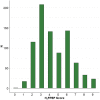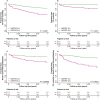Prognostic value of the H2 FPEF score in patients undergoing transcatheter aortic valve implantation
- PMID: 33215870
- PMCID: PMC7835574
- DOI: 10.1002/ehf2.13096
Prognostic value of the H2 FPEF score in patients undergoing transcatheter aortic valve implantation
Abstract
Aims: The aim of this study was to assess the prognostic value of the H2 FPEF score in patients undergoing transcatheter aortic valve implantation (TAVI) for severe aortic stenosis (AS) and preserved left ventricular ejection fraction (EF).
Methods and results: In this multicentre study, a total of 832 patients from two German high-volume centres, who received TAVI for severe AS and preserved EF (≥50%), were identified for calculation of the H2 FPEF score. Patients were dichotomized according to low (0-5 points; n = 570) and high (6-9 points; n = 262) H2 FPEF scores. Kaplan-Meier and Cox regression analyses were applied to assess the prognostic impact of the H2 FPEF score. We observed a decrease in stroke volume index (-2.04 mL/m2 /point) and mean transvalvular gradients (-1.14 mmHg/point) with increasing H2 FPEF score translating into a higher prevalence of paradoxical low-flow, low-gradient AS among patients with high H2 FPEF score. One year after TAVI, the rates of all-cause (low vs. high H2 FPEF score: 8.0% vs. 19.4%, P < 0.0001) and cardiovascular (CV) mortality (1.9% vs. 9.0%, P < 0.0001) as well as the rate of CV mortality or rehospitalization for congestive heart failure (6.4% vs. 23.2%, P < 0.0001) were higher in patients with high H2 FPEF score compared with those with low H2 FPEF score. After multivariable analysis, a high H2 FPEF score remained independently predictive of all-cause mortality [hazard ratio 1.59 (1.28-2.35), P = 0.018] and CV mortality or rehospitalization for congestive heart failure [hazard ratio 2.92 (1.65-5.15), P < 0.001]. Among the H2 FPEF score variables, atrial fibrillation, pulmonary hypertension, and elevated left ventricular filling pressure were the strongest outcome predictors.
Conclusions: The H2 FPEF score serves as an independent predictor of adverse CV and heart failure outcome among TAVI patients with preserved EF. A high H2 FPEF score is associated with the presence of paradoxical low-flow, low-gradient AS, the HFpEF in patients with AS. By identifying patients in advanced stages of HFpEF, the H2 FPEF score might be useful as a risk prediction tool in patients with preserved EF scheduled for TAVI.
Keywords: Aortic stenosis; H2FPEF score; HFpEF; Paradoxical low gradient; TAVI.
© 2020 The Authors. ESC Heart Failure published by John Wiley & Sons Ltd on behalf of European Society of Cardiology.
Conflict of interest statement
S.L., M.L., O.D.B., and L.V. received travel compensation (TC) from Edwards Lifesciences. C.P. received TC from Edwards Lifesciences and Boston Scientific. D.K. received TC and speaker honoraria (SH) from Abbott and TC and proctor fees from Edwards Lifesciences. J.S. is a proctor for Symetis and JenaValve. M.S. served as consultant for JenaValve, received TC from Abbott, Edwards Lifesciences, Symetis, and Biotronik, and received SH from Medtronic and Boston Scientific. H.R. received SH from Edwards Lifesciences. L.C. is a proctor for and received SH as well as TC from JenaValve, Edwards Lifesciences, Boston Scientific, and Medtronic and is a consultant for Edwards Lifesciences. M.J. received research grants and SH from Boston Scientific and Edwards Lifesciences. N.S. received TC from Edwards Lifesciences and St. Jude Medical, as well as SH and TC from Boston Scientific. All other authors report no relationships that could be construed as a conflict of interest.
Figures



Similar articles
-
Long-term prognostic value of the H2FPEF score in patients undergoing transcatheter aortic valve implantation.ESC Heart Fail. 2024 Aug;11(4):2159-2171. doi: 10.1002/ehf2.14773. Epub 2024 Apr 12. ESC Heart Fail. 2024. PMID: 38607328 Free PMC article.
-
Risk prediction in patients with low-flow, low-gradient aortic stenosis and reduced ejection fraction undergoing TAVI.Open Heart. 2022 Jan;9(1):e001912. doi: 10.1136/openhrt-2021-001912. Open Heart. 2022. PMID: 34987075 Free PMC article.
-
Heart Failure With Preserved Ejection Fraction Phenotype Is Associated With Early Symptom Onset in Aortic Stenosis and Residual Symptoms After Transcatheter Aortic Valve Implantation.J Am Heart Assoc. 2025 May 6;14(9):e038786. doi: 10.1161/JAHA.124.038786. Epub 2025 Apr 16. J Am Heart Assoc. 2025. PMID: 40240943 Free PMC article.
-
Predictive value of H2 FPEF score in patients with heart failure with preserved ejection fraction.ESC Heart Fail. 2021 Apr;8(2):1244-1252. doi: 10.1002/ehf2.13187. Epub 2021 Jan 5. ESC Heart Fail. 2021. PMID: 33403825 Free PMC article.
-
Meta-Analysis of the Prognostic Impact of Stroke Volume, Gradient, and Ejection Fraction After Transcatheter Aortic Valve Implantation.Am J Cardiol. 2015 Sep 15;116(6):989-94. doi: 10.1016/j.amjcard.2015.06.027. Epub 2015 Jun 26. Am J Cardiol. 2015. PMID: 26195275 Review.
Cited by
-
HFA-PEFF score: prognosis in patients with preserved ejection fraction after transcatheter aortic valve implantation.ESC Heart Fail. 2022 Apr;9(2):1071-1079. doi: 10.1002/ehf2.13774. Epub 2022 Jan 29. ESC Heart Fail. 2022. PMID: 35092186 Free PMC article.
-
Running on empty: Factors underpinning impaired cardiac output reserve in heart failure with preserved ejection fraction.Exp Physiol. 2025 May;110(5):694-707. doi: 10.1113/EP091776. Epub 2024 Feb 29. Exp Physiol. 2025. PMID: 38421268 Free PMC article. Review.
-
Impact of Modified H2FPEF Score on Chronic Limb-Threatening Ischemia in Patients With Lower Extremity Artery Disease Who Underwent Endovascular Therapy.Circ Rep. 2022 Jul 15;4(8):378-387. doi: 10.1253/circrep.CR-22-0063. eCollection 2022 Aug 10. Circ Rep. 2022. PMID: 36032384 Free PMC article.
-
Scoring of cardiac damage evaluated by echocardiography predicts prognosis of patients with severe aortic stenosis undergoing transcatheter aortic valve implantation: analysis of the LAPLACE-TAVI registry.Heart Vessels. 2025 Jul 11. doi: 10.1007/s00380-025-02569-9. Online ahead of print. Heart Vessels. 2025. PMID: 40643624
-
Prognostic Value of HFA-PEFF Score in Patients Undergoing Transcatheter Aortic Valve Implantation.Cureus. 2022 Jul 22;14(7):e27152. doi: 10.7759/cureus.27152. eCollection 2022 Jul. Cureus. 2022. PMID: 36017287 Free PMC article.
References
-
- Owan TE, Hodge DO, Herges RM, Jacobsen SJ, Roger VL, Redfield MM. Trends in prevalence and outcome of heart failure with preserved ejection fraction. N Engl J Med 2006; 355: 251–259. - PubMed
-
- Lam CSP, Gamble GD, Ling LH, Sim D, Leong KTG, Yeo PSD, Ong HY, Jaufeerally F, Ng TP, Cameron VA, Poppe K, Lund M, Devlin G, Troughton R, Richards AM, Doughty RN. Mortality associated with heart failure with preserved vs. reduced ejection fraction in a prospective international multi‐ethnic cohort study. Eur Heart J 2018; 39: 1770–1780. - PubMed
-
- Shiga T, Suzuki A, Haruta S, Mori F, Ota Y, Yagi M, Oka T, Tanaka H, Murasaki S, Yamauchi T, Katoh J, Hattori H, Kikuchi N, Watanabe E, Yamada Y, Haruki S, Kogure T, Suzuki T, Uetsuka Y, Hagiwara N, HIJ‐HF II Investigators . Clinical characteristics of hospitalized heart failure patients with preserved, mid‐range, and reduced ejection fractions in Japan. ESC Hear Fail 2019; 6: 475–486. - PMC - PubMed
-
- Fonarow GC, Stough WG, Abraham WT, Albert NM, Gheorghiade M, Greenberg BH, O'Connor CM, Sun JL, Yancy CW, Young JB, OPTIMIZE‐HF Investigators and Hospitals . Characteristics, treatments, and outcomes of patients with preserved systolic function hospitalized for heart failure: a report from the OPTIMIZE‐HF Registry. J Am Coll Cardiol 2007; 50: 768–777. - PubMed
Publication types
MeSH terms
LinkOut - more resources
Full Text Sources
Medical
Research Materials

